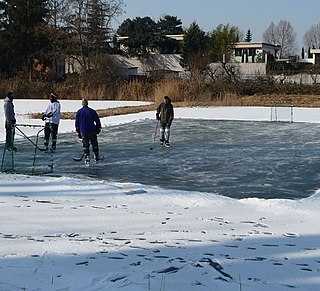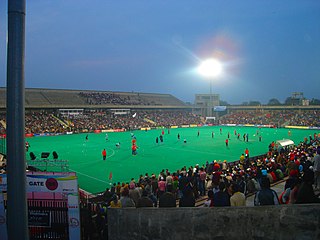The Comanche or Nʉmʉnʉʉ is a Native American tribe from the Southern Plains of the present-day United States. Comanche people today belong to the federally recognized Comanche Nation, headquartered in Lawton, Oklahoma.

Gerónimo was a military leader and medicine man from the Bedonkohe band of the Ndendahe Apache people. From 1850 to 1886, Geronimo joined with members of three other Central Apache bands – the Tchihende, the Tsokanende and the Nednhi – to carry out numerous raids, as well as fight against Mexican and U.S. military campaigns in the northern Mexico states of Chihuahua and Sonora and in the southwestern American territories of New Mexico and Arizona.

Pick-up sticks, pick-a-stick, jackstraws, jack straws, spillikins, spellicans, or fiddlesticks is a game of physical and mental skill in which a bundle of sticks, between 8 and 20 centimeters long, is dropped as a loose bunch onto a table top into a random pile. Each player, in turn, tries to remove a stick from the pile without disturbing any of the others. The object of the game is to pick up the most sticks or to score the most points based on the color of the sticks.

Capture the Flag (CTF) is a traditional outdoor sport where two or more teams each have a flag and the objective is to capture the other team's flag, located at the team's "base", and bring it safely back to their own base. Enemy players can be "tagged" by players when out of their home territory and, depending on the rules, they may be out of the game, become members of the opposite team, be sent back to their own territory, be frozen in place, or be sent to "jail" until freed by a member of their own team.

Yutnori (Korean: 윷놀이), also known as yut, nyout and yoot, is a traditional board game played in Korea, especially during Korean New Year. The game is also called cheoksa or sahui.

Get the Picture is a children's game show that aired from March 18 to December 6, 1991, with repeats until March 13, 1993 on Nickelodeon. Hosted by Mike O'Malley, the show featured two teams answering questions and playing games for the opportunity to guess a hidden picture on a giant screen made up of 16 smaller screens. The show was recorded at Nickelodeon Studios in Universal Studios, Orlando, Florida. The program's theme music and game music was composed by Dan Vitco and Mark Schultz, and produced by Schultz. Its tagline is The Great Frame Game.

Handgame, also known as stickgame, is a Native American guessing game, in which marked "bones" are concealed in the hands of one team while another team guesses their location.

Stick gambling is a traditional hand game played by many indigenous people, with the rules varying among each group. It would typically be played when diverse groups met on the trail. Games could last for several days during which prized matches, shot, gunpowder, or tobacco would be staked. Traditionally, only men would take part. However in modern games, both genders are able to play. The Yukon Territory First Nations in Canada holds many annual hand games, or stick gambling tournaments, in which both genders play.

Pond hockey is a form of ice hockey similar in its object and appearance to traditional ice hockey, but simplified and designed to be played on part of a natural frozen body of water. The rink is 50 to 80 percent the size of a standard NHL-specification rink, and has no boards or glass surrounding it; usually only a barrier of snow keeps the puck in play. In addition, because there are no protective barriers behind the goal to contain high errant shots, the top of the goal is lower, in fact only slightly taller than the width of a puck, and the game does not have a formal goalie. Because of these differences, pond hockey places more emphasis on skating and puckhandling ability and less on shooting and checking. Non-competitive pond hockey is played with improvised goals, rinks of a variety of sizes, and no boards or snow barriers. There can only be 4 players playing per team at a time but have many subs to sub in.

Slahal is a gambling game played by the Coast Salish peoples in the western United States and Canada, specifically in the lower Fraser Valley area of British Columbia, parts of Vancouver Island, and north-western parts of Washington State. The game was shared in common by the Chehalis, Chemakum, Chemainus, Chilliwack, Comox, Cowichan, Klahuse, Klallam, Lummi, Nanaimo, Nisqually, Pentlatch, Puyallup, Quileute, Quinault, Sanich, Sechelt, Skokomish, Snohomish, Snoqualmie, Songhees, Squamish, and Twana peoples.
Jereed, known by the name Equestrian Javelin is a traditional Turkish equestrian team sport played outdoors on horseback in which the objective is to score points by throwing a blunt wooden javelin at opposing team's horsemen. Played by Turkic peoples in Central Asia as the essential sporting and ceremonial game, it was brought to Anatolia during the westward migration in the beginning of the 11th century.
Squamish culture is the customs, arts, music, lifestyle, food, painting and sculpture, moral systems and social institutions of the Squamish indigenous people, located in the southwestern part of British Columbia, Canada. They refer to themselves as Sḵwx̱wú7mesh. They are a part of the Coast Salish cultural group. Their culture and social life is based on the abundant natural resource of the Pacific Northwest coast, rich in cedar trees, salmon, and other resources. They have complex kinship ties that connect their social life and cultural events to different families and neighboring nations.

Chief Yowlachie , also known as Daniel Simmons; was a Native American actor from the Yakama tribe in the U.S. state of Washington, known for playing supporting roles and bit parts in numerous films. He is perhaps best known for playing Two Jaw Quo, Nadine Groot's assistant cook, in the classic 1948 Western Red River.
Several folk dance forms evolved in different regions of Odisha, Odissi and Chhau being some popular forms. Sambalpuri dance is most popular dance of western Odisha and is enjoyed by many.

Indigenous North American stickball is a team sport typically played on an open field where teams of players with two sticks each attempt to control and shoot a ball at the opposing team's goal. It shares similarities to the game of lacrosse. In Choctaw Stickball, "Opposing teams use handcrafted sticks, or kabocca, and a woven leather ball, or towa. Each team tries to advance the ball down the field to the other team's goalpost using only their sticks, never touching or throwing the ball with their hands. Points are scored when a player hits the opposing team's goalpost with the ball."

Punjabis play a wide variety of sports and games, ranging from modern games such as hockey and cricket, to the more traditional games such as Kabaddi, Kushtian (wrestling) and Khuddo khoondi. There are over 100 traditional games and sports of Punjab.
Pugasaing is a Native American dice game played by the Ojibwe. It is mentioned by name in Henry Wadsworth Longfellow's poem, The Song of Hiawatha. The word pugasaing is the participle form of the verb "to throw" in the Ojibwe language.

Early Native American recreational activities consisted of diverse sporting events, card games, and other innovative forms of entertainment. Most of these games and sporting events were recorded by observations from the early 1700s. Common athletic contests held by early American tribes included games of stickball, chunkey, archery, darts, foot races, and canoeing. Card and dice games were commonly used as forms of entertainment among tribes such as the Iroquois and Lakota. Several contests and games invented by American indigenous groups contributed to modern-day sports and casino play. Several indigenous games were tribe-specific; one of the most common games played specifically by the Iroquoian was the Bowl Game, played using colored balls and sticks.
Tellstones: King's Gambit is a 2020 tabletop game created by Riot Games under their Riot Tabletop division. Two or four players take turns placing, swapping, and guessing tokens; the goal of the game is to either guess three tokens correctly or "boast" successfully by correctly guessing all hidden tokens. Developed as part of Riot's expansion into games outside League of Legends, the game is the company's second tabletop product following their 2016 release Mechs vs. Minions. Tellstones was released in September 2020; reviewers praised the game for its presentation and build quality, but criticized its gameplay as short and uninteresting.

The ancient Romans had a variety of toys and games. Children used toys such as tops, marbles, wooden swords, kites, whips, seesaws, dolls, chariots, and swings. Gambling and betting were popular games in ancient Rome. Legislation heavily regulated gambling; however, these laws were likely not enforced. Tali, Terni lapilli, Duodecim Scripta, and Ludus latrunculorum were all popular games in ancient Rome. They were similar to poker, tic-tac-toe, backgammon, and chess respectively. Nine men's morris may also have been a popular game in ancient Rome. Roman children also played games simulating historical battles and could pretend to be important government officials.
















